Cleaning your space is more important now than ever. With the ongoing threat of germs and viruses, having a strong cleaning plan helps keep your business safe. You will learn about pandemic-ready cleaning procedures that can protect your workplace.
Table of Contents
Key Takeaways
- Follow strict cleaning routines to reduce germs.
- Use the right products for effective disinfection.
- Train your staff on cleaning best practices.
- Create a cleaning plan that fits your business needs.
- Stay informed about local health guidelines.
- Explore professional cleaning services to enhance your cleaning efforts. [Link to Professional Cleaning Services]
Understanding Pandemic-Ready Cleaning Procedures
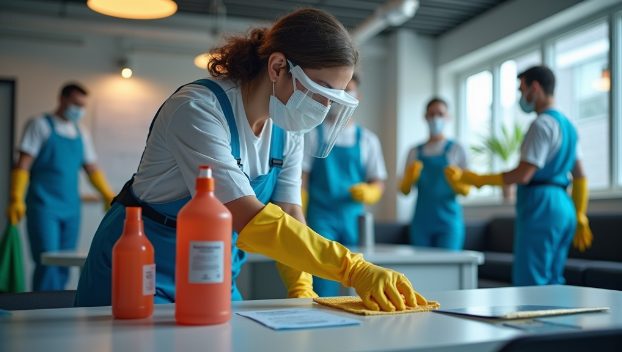
Pandemic-ready cleaning means having a plan that goes beyond regular cleaning. This plan focuses on stopping the spread of germs. You want to keep your workspace safe for employees and customers. This involves cleaning more often and using products that kill viruses and bacteria.
Recommended Cleaning Frequency for Different Areas
| Area | Cleaning Frequency | Suggested Products |
|---|---|---|
| High-Traffic Areas | Daily | EPA-approved disinfectants |
| Common Areas (break rooms) | Every 2-3 hours | Multi-surface cleaners |
| Restrooms | After each use | Toilet bowl cleaners |
| Office Desks | Daily | Disinfectant wipes |
Why is Pandemic-Ready Cleaning Procedures Important?
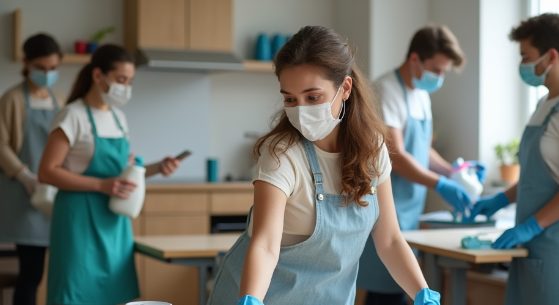
Cleaning is not just about making your space look nice. It is about health. A clean workplace helps stop the spread of illnesses. When surfaces are clean, there are fewer chances for germs to spread. This is especially true in places like offices, schools, and medical facilities.
Key Steps in Pandemic-Ready Cleaning
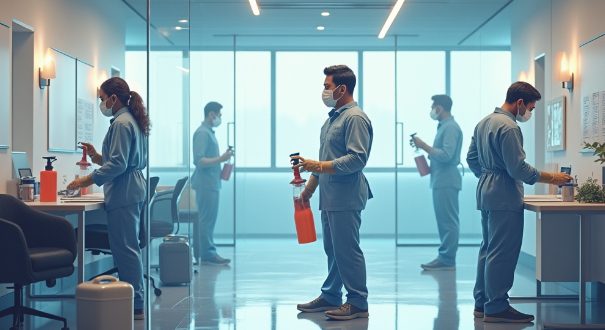
1. Create a Cleaning Schedule
Having a schedule is one of the first steps in pandemic-ready cleaning. You should decide how often to clean different areas. High-traffic areas may need daily cleaning. Less-used areas could be cleaned weekly.
2. Use the Right Tools and Products
Not all cleaners are the same. It is important to choose products that kill germs. Look for products that are approved by the Environmental Protection Agency (EPA) for killing viruses. Using these products makes your cleaning more effective.
3. Train Your Staff
Your cleaning team should know how to use cleaning products properly. They need training on how to clean different surfaces. This includes knowing which products to use and how to apply them. When staff are trained, they can do a better job of keeping spaces clean and safe.
4. Focus on High-Touch Areas
Some surfaces collect more germs than others. These are known as high-touch areas. Examples include doorknobs, light switches, and shared equipment. Make sure these areas are cleaned often.
5. Encourage Good Hygiene
It is not all about cleaning. Good hygiene practices help too. Encourage everyone in your space to wash their hands regularly. Provide hand sanitizer at entrances and common areas. This makes it easier for everyone to stay clean.
Additional Hygiene Practices to Promote
- Provide personal hand sanitizers to employees.
- Set reminders for regular handwashing breaks.
- Offer disposable masks in shared spaces.
Local Considerations for Minneapolis
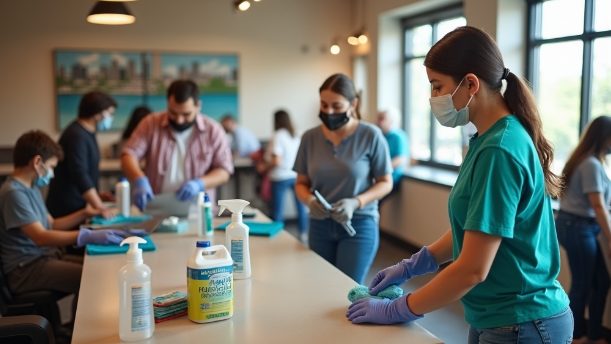
In Minneapolis, it’s essential to follow local health guidelines. The Minnesota Department of Health offers resources on medical cleaning and sanitizing. They provide guidelines that help businesses stay compliant with health standards.
Keeping Up with Changes
The situation with germs and viruses can change. It is important to stay updated with the latest information. Check local news and health department updates regularly. This way, your business can adapt its cleaning plan as needed.
Common Cleaning Products and Their Uses
| Product Type | Usage | Example Brands |
|---|---|---|
| Disinfectant Wipes | Surface cleaning | Clorox, Lysol |
| Hand Sanitizer | Hand hygiene | Purell, Germ-X |
| EPA-Approved Cleaners | General cleaning and disinfecting | Seventh Generation, Method |
Practical Tips for Pandemic-ready Cleaning Procedures
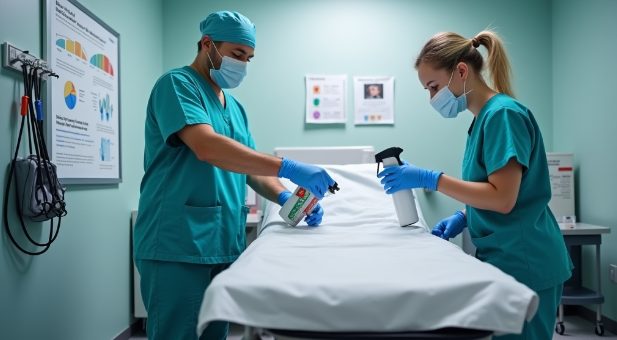
Use EPA-Approved Cleaners
When shopping for cleaning products, look for those labeled as EPA-approved. This means they have been tested to kill viruses effectively. Always read the labels to ensure the product is suitable for the surfaces you are cleaning.
Establish a Routine
Make cleaning a regular part of your day. Set specific times for cleaning. For example, cleaning common areas every morning before work starts can help keep your space safe.
Don’t Forget About Air Quality
Good air quality is important. Consider using air purifiers in your space. They can help remove germs and improve the air you breathe. Make sure to change filters regularly.
Disinfect After Illness
If someone in your workplace becomes sick, disinfect that area immediately. This can help prevent the spread of illness to others. Notify your cleaning staff so they can take extra precautions.
Communicate with Your Team
Let your employees know about the cleaning procedures. When they understand what is being done, they will feel safer. Share your cleaning schedule and the products you are using during meetings or through emails.
Advanced Cleaning Techniques
Some businesses may want to go beyond basic cleaning. Here are a few advanced techniques to consider.
Electrostatic Spraying
Electrostatic spraying is a way to disinfect large areas quickly. This method uses a special machine that charges the cleaning solution. It allows the solution to wrap around surfaces and coat them evenly. This method is especially useful in larger spaces.
Fogging
Fogging is another method that uses a fine mist to disinfect. It reaches areas that are hard to clean by hand. This technique is great for larger facilities like schools and medical offices. It helps ensure that all surfaces are treated.
Regular Deep Cleaning
In addition to daily cleaning, regular deep cleaning is important. This could happen monthly or quarterly. Deep cleaning means getting into hard-to-reach areas and ensuring everything is sanitized.
Staying Prepared for Future Pandemics
While we hope for a healthier future, it’s smart to stay prepared. Here are some ways to keep your business ready for any health crisis.
Plan for the Unexpected
Having a plan in place is crucial. Make sure you know how to respond if an illness spreads through your workplace. This can include shutting down for a deep clean or altering your cleaning schedule.
Stock Up on Supplies
Keep a stock of cleaning supplies on hand. This prevents running out during a crisis when demand is high. Make a list of the items you need to keep your space clean and safe. Also, consider stocking up on emergency cleaning solutions such as disinfectant wipes, hand sanitizer, and bleach. These items can be crucial for ensuring a safe and sanitized environment, especially during times when the risk of illness is high. By being prepared with a stock of cleaning supplies and emergency cleaning solutions, you can maintain a clean and healthy space for yourself and others.
Keep Your Team Informed
Make sure your staff knows what to do in case of an outbreak. Regularly update them on cleaning procedures and health guidelines. This helps everyone stay on the same page.
Conclusion
Pandemic-ready cleaning procedures are essential for any business. With the right plan in place, you can keep your space clean and safe. Following these tips will help protect your employees and customers. Remember to use the right products, train your team, and stay informed about local health guidelines. By doing so, your business can thrive in a clean environment.
Final Thoughts
Pandemic-ready cleaning procedures is never just about appearances. It is about health and safety. Investing in cleaning now can make a big difference. You protect your employees, customers, and the community. So, take action and implement these pandemic-ready cleaning procedures today!
By maintaining a strong cleaning plan, you help everyone feel more secure. The health and safety of your business depend on it. If you want to learn more about Pandemic-ready cleaning procedures , feel free to reach out to Health Point Cleaning Solutions. We are here to help!

